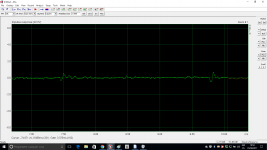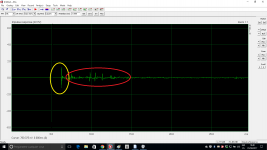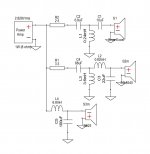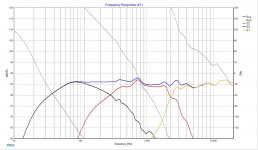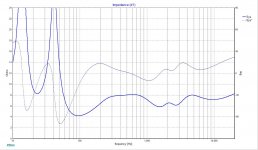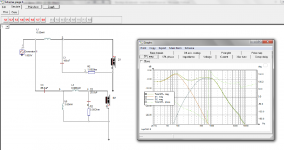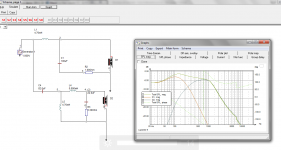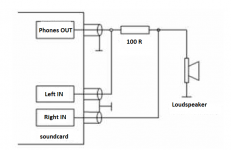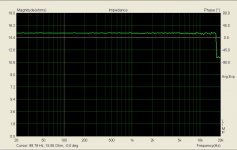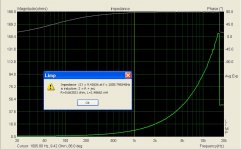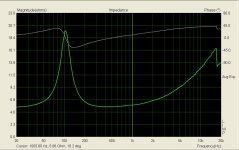Bufff, you have so many and so stong reflexions in the first 5ms, so we can't make any idea if the bump is due to reflexions or to a problem with the crossover.
Only thing we can do is repeating the measurement a different distances and locations to make a better idea.
One measurement at 1m at listening height for instance...
Only thing we can do is repeating the measurement a different distances and locations to make a better idea.
One measurement at 1m at listening height for instance...
6.5ms to 10ms?
No, the speaker response is the yellow area, the red are the early reflections.
In fact to check an xover so low we need at least 5-10ms free of reflexions, and that makes adjusting a 3 way indoor so difficult. For a tweeter with about 3ms are enough, tough not ideal.
Attachments
OK, I will do asap, I don't know if I can measure tomorrow but maximum monday I will do and post.
Last edited:
But it is also clear that we have no FR data of the scanspeak, excepted that we now by its datasheet of a bump in the 500-1000hz, and probably edge diffractions from the cabinet boost this area too...
But without measurement data to feed the simulator..
But without measurement data to feed the simulator..

But it is also clear that we have no FR data of the scanspeak, excepted that we now by its datasheet of a bump in the 500-1000hz, and probably edge diffractions from the cabinet boost this area too...
But without measurement data to feed the simulator..
How can do for data measurement?
How can do for data measurement?
I suppose you have the registered Arta and can save measurements, so just shoot a measurement of the SS monitor from about 50-60cms without hipass save the impulse ( *.pir file) and upload it.
Of course, if you can take that away from the walls, much better...
Wow Lojzek thank you very much to do all this work for me. I wil try asap.
Thanks and have a nice week-end.
Felipe
Thanks and have a nice week-end.
Felipe
See whether you can use this for starters.
I agree that lowering the xover point might bring the beneficial side effect of boosting the SBA response around 100hz for a better balance vs the SS midrange level above xover freq.
Attachments
Last edited:
See whether you can use this for starters.
R1 & R2 are true resistors right?
In this theoretical design, its purpose is to bring down the spl of mid and tweeter closer to woofer. Just a proposal to start from somewhere. You can modify it in any way that measures better.
It seems that the bump in the response 500-1000hz definitely belongs to the SS when mounted on small baffle.

http://www.audioexcite.com/?page_id=4894
Probably other reflections make things worse in your case, at the listening distance...

http://www.audioexcite.com/?page_id=4894
Probably other reflections make things worse in your case, at the listening distance...
Last edited:
It seems that the bump in the response 500-1000hz definitely belongs to the SS when mounted on small baffle.
Definitely. I have similiar troubleshooting region 700-1000Hz with 200mm baffle.
Creative Sound Blaster 128 + ARTA LIMP 1.7
I wanted to try this really old soundcard and so I've followed the user manual to perform impedance measurements and at first id didn' work well for it was showing impedance of DUT and a series 100 ohm resistor together. So I have swapped the input channels and it was okay then. It seems that sound card is good until 16-17 kHz. At first I did the loopback calibration but since the channel difference was 0,18 dB I've repeated the calibration with 100 ohm resistor in place without the DUT (device under test) which improved the results.
I wanted to try this really old soundcard and so I've followed the user manual to perform impedance measurements and at first id didn' work well for it was showing impedance of DUT and a series 100 ohm resistor together. So I have swapped the input channels and it was okay then. It seems that sound card is good until 16-17 kHz. At first I did the loopback calibration but since the channel difference was 0,18 dB I've repeated the calibration with 100 ohm resistor in place without the DUT (device under test) which improved the results.
Attachments
At first I did the loopback calibration but since the channel difference was 0,18 dB I've repeated the calibration with 100 ohm resistor in place without the DUT (device under test) which improved the results.
I don't understand... When you run the calibration process, Limp checks for imbalance and if imbalance is less than 2dbs, it self calibrates indicating you the value of the imbalance found.
In other words, when after running calibration Limp informs that channel difference is 0,18dB, it is not an error message, it simply means that calibration has been achieved successfully and this 0.18dB difference will be accounted for in the measurements further performed.
- Status
- Not open for further replies.
- Home
- Loudspeakers
- Multi-Way
- Xover to filter woofer SB 23NRSX45-8
